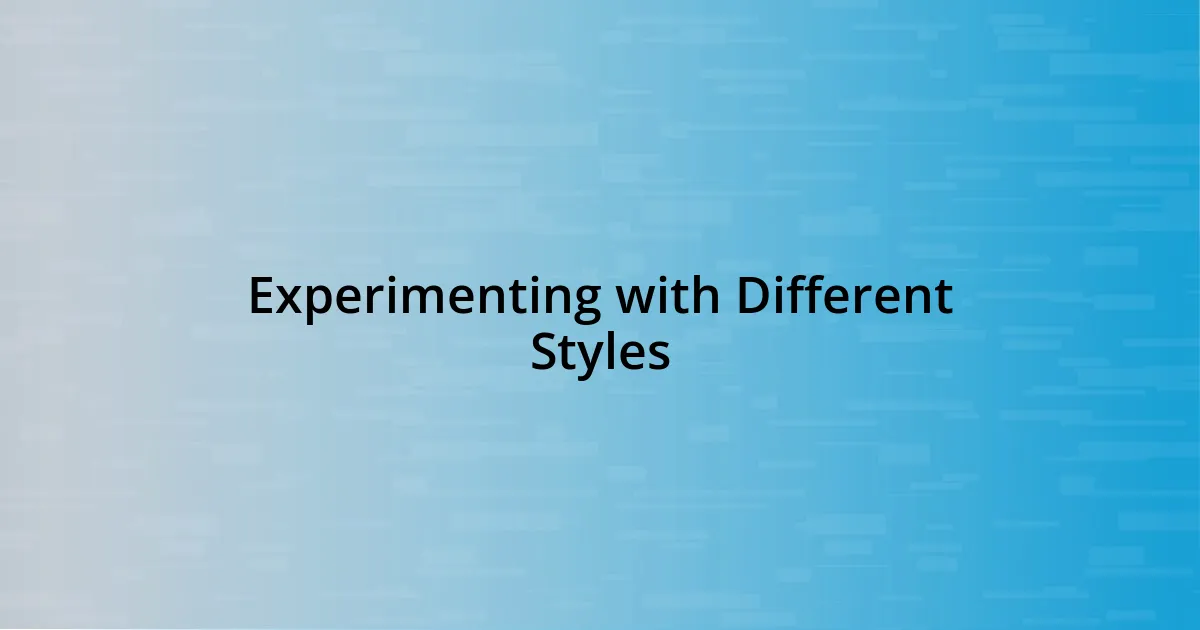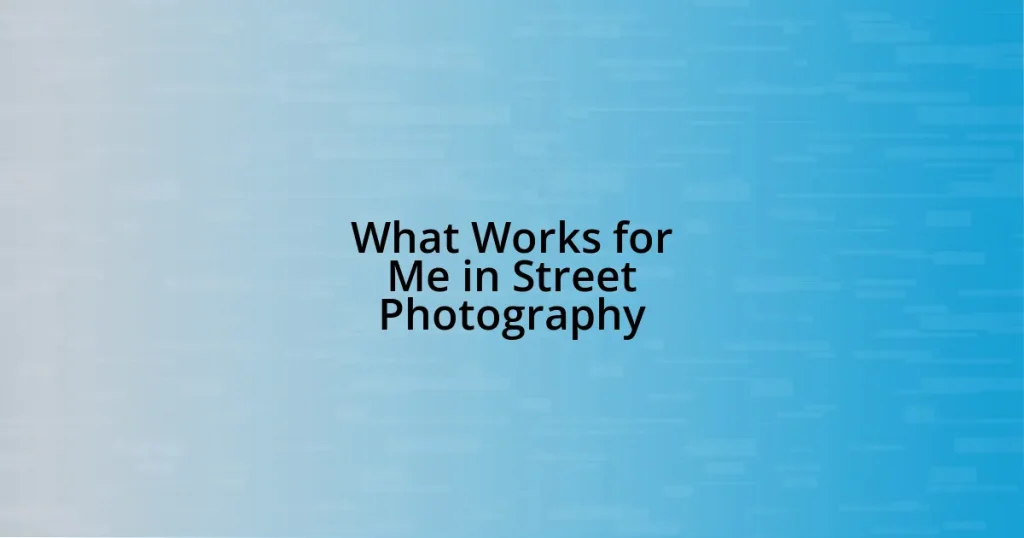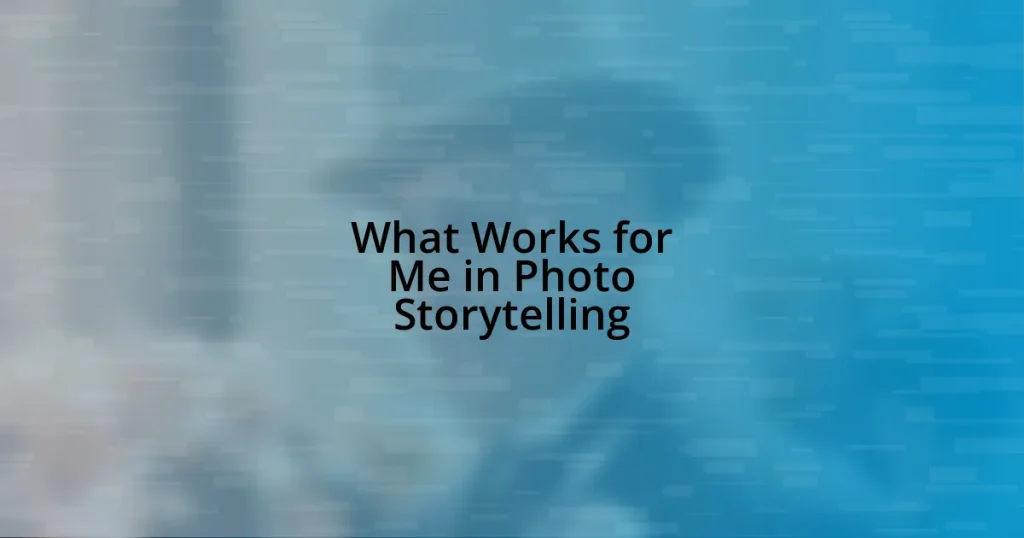Key takeaways:
- Finding inspiration in nature, travel, and old photographs fosters creativity and emotional connection in photography.
- Mastering photography techniques like exposure, aperture, and composition shapes narrative and enhances expressive potential.
- Experimenting with various styles diversifies skills and deepens appreciation for the art form.
- Establishing consistent editing habits and a signature look helps create a coherent aesthetic while maintaining personal artistic voice.

Finding Your Photography Inspiration
When I first started exploring photography, inspiration often felt elusive. One afternoon, I wandered through a local park, and the way the sunlight filtered through the leaves struck me—suddenly, every leaf was a potential subject. Isn’t it fascinating how nature can offer such profound moments if we take the time to truly observe?
Travel has also been a significant source of inspiration for me. I remember a trip to a bustling market; the vibrant colors and the stories woven into each face captured on camera were electrifying. How can we draw inspiration from our surroundings if we’re always in a rush? Slowing down opens up a world of creativity.
I’ve found that revisiting my old photographs can ignite new ideas and spark excitement. One evening, I stumbled upon a collection of images from a rainy day; each droplet seemed to tell a story. Reflecting on those memories, I realized how much emotion can be captured in the ordinary—are there parts of your own journey that you haven’t yet explored through your lens?

Understanding Photography Techniques
Understanding various photography techniques is crucial in developing a unique style. Early on, I experimented with manual settings on my camera, which felt daunting at first. But the moment I fully understood exposure, aperture, and shutter speed, I saw a dramatic shift in my work’s expressiveness. This foundational knowledge doesn’t just help in achieving a well-exposed image; it empowers you to tell stories through light and shadow.
For me, mastering depth of field opened up a new realm of creativity. My first portrait shoot came to life when I used a wide aperture to blur the background, allowing my subject’s personality to shine. It was an exhilarating realization that the technical aspect of photography could radically alter how a viewer perceives an image. How many of us understand the impact of these choices? Each decision shapes our narrative and the mood of our photos.
Composition techniques became a game-changer as I dove deeper into photography. The rule of thirds, leading lines, and framing instantly transformed my approach. I recall a sunrise shoot at the beach where I positioned the horizon in the lower third of the frame, which elevated the feeling of vastness effortlessly. Isn’t it intriguing how simple adjustments can turn an ordinary snapshot into an extraordinary image?
| Technique | Description |
|---|---|
| Exposure | The amount of light that reaches the sensor; relates to brightness. |
| Aperture | Controls the depth of field; impacts background blur. |
| Shutter Speed | Determines how motion is captured; fast speeds freeze motion. |
| Rule of Thirds | A compositional guideline that divides the frame into thirds. |
| Leading Lines | Guides the viewer’s eye along the photograph. |
| Framing | Using elements to frame the subject, adding depth to the image. |

Experimenting with Different Styles
Experimenting with different styles was a pivotal step in my photography journey. I remember the first time I tried street photography; the adrenaline rush was incredible. I loved capturing candid moments of life in motion. Each click of the shutter felt like an invitation into someone else’s story. This immersion helped me realize the beauty in raw, unfiltered moments.
- I dabbled in black-and-white photography, which taught me to focus on light and texture over color.
- Portraits became my playground; adjusting lighting completely transformed the mood of each image.
- I explored macro photography and was amazed at the intricate details of flowers and insects, revealing a hidden world.
- Landscape photography pushed me to connect with nature, be it during dawn or dusk for that perfect golden hour glow.
- Travel photography opened my eyes to diverse cultures and traditions, turning every frame into a colorful tapestry of human experiences.
My experimentation not only diversified my portfolio but also deepened my appreciation for the medium. Each new style brought with it a unique challenge and a distinct way to convey emotion—something I continue to cherish as I evolve artistically.

Defining Your Personal Vision
Defining my personal vision in photography was a journey filled with introspection and inspiration. I often found myself wandering through my favorite local parks, camera in hand, contemplating the type of imagery that truly resonated with me. One day, as I photographed a solitary tree against a vibrant sunset, it struck me how much I valued solitude in both nature and life. This realization became a cornerstone of my photographic style; I wanted to capture moments of stillness amid chaos.
In my quest for clarity, I started envisioning what I wanted to convey in my images. During a quiet evening spent photographing reflections on a still lake, I felt a deep connection to the calmness in my surroundings. The interplay between the water and the sky sparked a revelation: I wanted my photography to evoke feelings of peace and introspection in others. Isn’t it fascinating how a single moment can embody a vision and steer your artistic narrative?
As I honed in on my vision, I embraced vulnerability in my work. It was during a candid moment while observing a pair of elderly hands intertwined that I recognized the power of intimacy in photography. This experience made me realize the stories hidden within everyday moments—stories I wanted to share through my lens. I now ask myself, what emotions do I want to foster in my viewers? Crafting this vision began to shape my approach, enabling me to blend technical skills with personal emotion seamlessly.

Developing Consistent Editing Habits
Developing consistent editing habits has been a game-changer in my photography journey. Early on, I found that my post-processing process was all over the place. One day I would crank up the contrast, the next I’d boost the saturation. This inconsistency muddled my vision and made it hard to identify my style. Over time, I learned that establishing a set of editing guidelines not only streamlined my workflow but also helped me create a coherent aesthetic across my portfolio.
Setting up presets in Lightroom became one of my most valuable tools. Initially, I hesitated to use them, fearing they would strip my images of their uniqueness. However, I discovered that by tailoring presets to capture the essence of my vision, I could maintain my artistic voice while saving time. I still remember the moment I applied a consistent warm tone to a series of travel images; it instantly evoked nostalgia and warmth, setting the mood for viewers without sacrificing individuality.
I also made it a habit to review and refine my edits regularly. After each photography session, I’d take a moment to reflect on what aspects of my editing I loved and what felt off. This practice fostered a deeper connection to my work and allowed for continual growth. Have you ever noticed how our tastes evolve? Embracing this notion has helped me adapt my editing style as I explore new themes while staying true to my core vision. This iterative process keeps my work fresh and aligned with who I am as an artist.

Creating a Signature Look
Creating a signature look in photography is like finding your voice in a crowded room. I remember a particular day in the bustling streets of my city when I first experimented with low-angle shots of urban architecture. Capturing buildings towering over me made them feel more alive, encouraging me to connect with my surroundings in a way I hadn’t before. This new perspective sparked a desire to incorporate dramatic angles throughout my work, helping to define my signature style.
Once I recognized the importance of these unique angles, I started exploring color palettes that resonated deeply with my emotional state. For instance, after a particularly challenging week, I took a series of somber monochrome shots that reflected my mood. This deepened my understanding of how color—or the absence of it—could evoke feelings in the viewer. Have you ever thought about how colors influence your emotions? My exploration of vibrant hues and muted tones became essential to establishing a cohesive and emotionally engaging visual identity.
As I continued to refine my look, I discovered the key was to infuse personal experiences into my work. For example, during a family gathering, I captured candid moments that told stories of love and connection. The warmth and depth of those images became an important cornerstone of my style. It’s thrilling to see how each photograph can encapsulate a personal narrative—an invitation for viewers to experience a slice of my life through my lens. Isn’t it incredible how our experiences shape our artistic expressions?
















